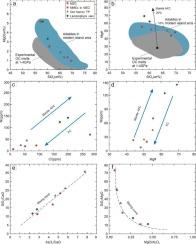IF 3.6
2区 地球科学
Q1 GEOLOGY
引用次数: 0
摘要
在该矿床中发现了三个不同阶段的中新世花岗岩体:前矿化斑岩二长花岗岩(PMG, 16.9 ~ 12.7 Ma)、同矿化二长花岗岩斑岩(MGP, 13.9 ~ 12.1 Ma)、后矿化英安岩斑岩(11.8 ~ 11.6 Ma)。这三个阶段的岩浆都具有高氧逸度和富氢的特点。但是,目前对含矿岩体与无矿岩体在岩浆来源、成矿物质来源上的差异以及巴荣铜钼矿床埃达克岩特征的成因尚不清楚。本文对百容矿床含矿二长花岗岩(MZG)、MZG内矿化基性包体(MMEs)和无矿化斑岩(TP)进行了系统的地球化学和Sr-Nd-Pb-Hf-O同位素分析。含矿MZG和MMEs表现出明显一致的Sr-Nd-Pb-Hf-O同位素组成。而无矿TP则表现出明显不同的同位素特征,εNd(t)值低至-8.65,87Sr/86Sr(t)比值高至0.707973。含矿MZG及其MMEs δ18O值低至5.2‰,Pb同位素比值也较低,其中206Pb/204Pb(t)、207Pb/204Pb(t)和208Pb/204Pb(t)的最小值分别为18.4968、15.6647和38.8553。这些同位素组成表明,MMEs及其寄主花岗岩类均起源于幔源性基性熔体和壳源性长英质岩浆的杂交作用。值得注意的是,含矿MZG和MMEs表现出比无矿TP更大的地幔贡献。白荣MMEs岩石圈地幔源及其寄主岩经历了交代作用,交代作用可能与特提斯洋俯冲成分有关。幔源岩浆的注入为成矿过程提供了额外的水和成矿金属元素。白荣岩浆的角闪岩特征可能是在岩浆分异过程(如角闪孔分异)中形成的,而不是直接继承于原始岩浆源。本文章由计算机程序翻译,如有差异,请以英文原文为准。

Origin and geodynamic setting of adakitic intrusions in the Bairong porphyry Cu–Mo deposit, central Gangdese Belt, Tibet
Situated in the heart of the Gangdese metallogenic province in southern Tibet, the Bairong Cu-Mo porphyry deposit anchors itself within the core sector of one of Asia’s most prolific porphyry Cu domains. Three distinct stages of Miocene granitic intrusions have been identified in this deposit: Pre–mineralized porphyritic monzogranite (PMG; 16.9‒12.7 Ma), syn-mineralized monzogranite porphyry (MGP; 13.9‒12.1 Ma), post–mineralized dacite porphyry (11.8–11.6 Ma). The magma from all three stages is characterized by high oxygen fugacity and H2O-rich. However, the differences in the sources of magma and ore-forming materials between ore-bearing and barren intrusions, as well as the genesis of adakite features in the Bairong Cu-Mo deposit, are not well understood. In this study, we conducted systematic geochemical and Sr-Nd-Pb-Hf-O isotopic analysis on the ore-bearing monzogranite (MZG), mineralized mafic enclaves (MMEs) within the MZG and ore-barren tonalite-porphyrite (TP) from the Bairong deposit. The ore-bearing MZG and MMEs exhibit remarkably consistent Sr–Nd–Pb–Hf–O isotopic compositions. In contrast, the ore-barren TP displays distinctly different isotopic signatures, characterized by significantly lower εNd(t) values (as low as –8.65) and markedly higher 87Sr/86Sr(t) ratios (up to 0.707973). The ore-bearing MZG and its MMEs also show notably lower δ18O values (down to 5.2 ‰) and lower Pb isotopic ratios, with 206Pb/204Pb(t), 207Pb/204Pb(t), and 208Pb/204Pb(t) reaching minimum values of 18.4968, 15.6647, and 38.8553, respectively. These isotopic compositions indicate that both the MMEs and their host granitoids originated through hybridization between mantle-derived mafic melts and crustal-derived felsic magmas. Notably, the ore-bearing MZG and MMEs exhibit a greater mantle contribution than the ore-barren TP. The lithospheric mantle source of the Bairong MMEs and their host rocks experienced metasomatism, with the metasomatic agents likely related to subducted components from the Tethyan Ocean. The injection of mantle-derived magmas contributed additional water and ore-forming metal elements to the mineralization process. The adakitic features of the Bairong magmas likely formed during magmatic differentiation (e.g., amphibole fractionation) rather than being directly inherited from their primary magma source.
求助全文
通过发布文献求助,成功后即可免费获取论文全文。
去求助
来源期刊

Ore Geology Reviews
地学-地质学
CiteScore
6.50
自引率
27.30%
发文量
546
审稿时长
22.9 weeks
期刊介绍:
Ore Geology Reviews aims to familiarize all earth scientists with recent advances in a number of interconnected disciplines related to the study of, and search for, ore deposits. The reviews range from brief to longer contributions, but the journal preferentially publishes manuscripts that fill the niche between the commonly shorter journal articles and the comprehensive book coverages, and thus has a special appeal to many authors and readers.
 求助内容:
求助内容: 应助结果提醒方式:
应助结果提醒方式:


